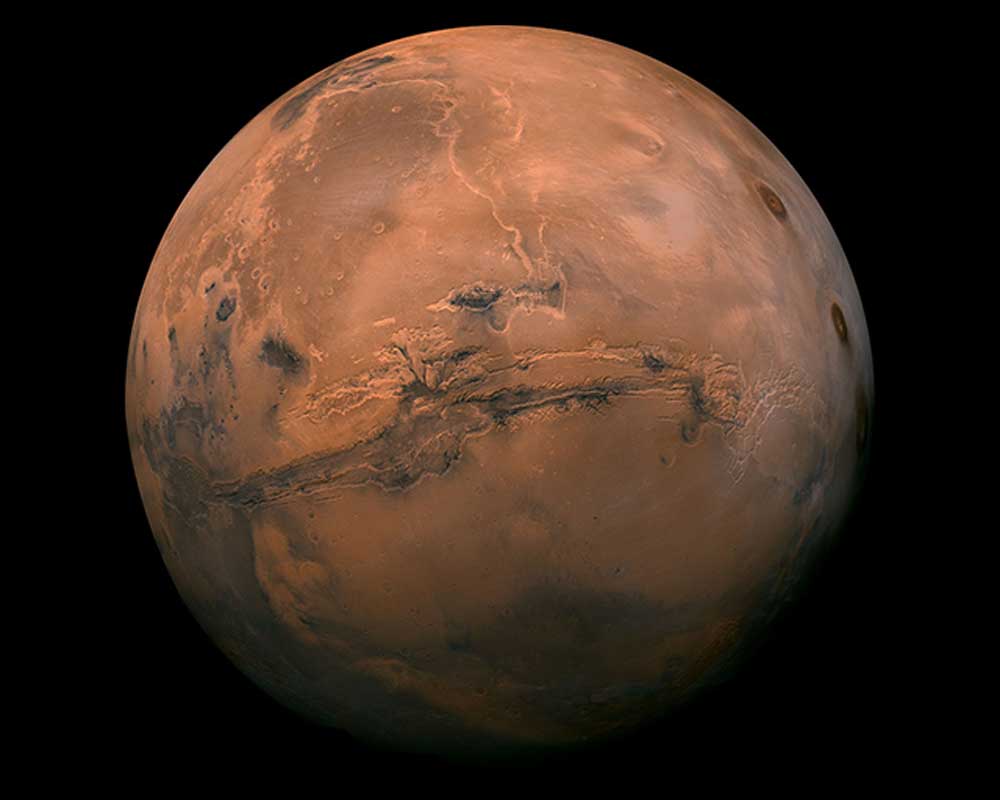There is something about the red planet that has always captured our imagination. Perhaps it’s the fact that it is the closest planet to Earth or its striking color. Mars has always been a source of fascination for astronomers and scientists, and continues to be a subject of study today. In this article, we will take a closer look at Mars – its history, discovery, physical characteristics, and more. We hope you find it as interesting as we do!
Mars is the fourth planet from the Sun and the second smallest planet in the solar system. Named after the Roman god of war, it is often described as the “Red Planet” because of its reddish appearance. Mars is a terrestrial planet with a thin atmosphere, having surface features reminiscent both of the impact craters of the Moon and the valleys, deserts, and polar caps of Earth. The planet may have gotten its red color from iron oxide, or rust, on its surface.

Mars discovery and names
The first recorded observation of Mars was by Egyptian astronomers in the second millennium BC. In 1609, Galileo Galilei observed Mars with a telescope, becoming the first person to do so. In 1757, Immanuel Kant proposed the name “Mars” for the planet in his treatise Cosmographia.
The red planet has been known by many names throughout history. The Babylonians called it “Nergal,” after their god of war. The Greeks called it “Ares,” after their god of war. The Romans called it “Mars,” after their god of war.
Mars diameter and mass
Mars has a diameter of 6,780 kilometers, which makes it the second-smallest planet in the Solar System, after Mercury. It is approximately half of Earth’s diameter. It has a mass that is about 11% of Earth’s mass.
Composition
Mars is a terrestrial planet that formed about four and a half billion years ago. Mars is believed to have formed from the same disk of gas and dust that formed the other planets in the solar system. The composition of Mars is similar to that of Earth, with a rocky surface and an iron core.
It has many volcanoes, canyons, and mountains. The tallest mountain on Mars is Olympus Mons, which is about three times the height of Mount Everest. Mars also has the largest canyon in the solar system, Valles Marineris.
Climate
Mars has a thin atmosphere that is mostly made up of carbon dioxide. There is also some water vapor and nitrogen in the atmosphere. The atmospheric pressure on Mars is only about one percent of that on Earth. It has a thin atmosphere and no oceans and is covered in red-orange dust.
The temperature on Mars can range from very cold to very hot, depending on where you are on the planet. The average temperature is about -60 degrees Celsius. However, in some areas near the equator, the temperature can be as high as 20 degrees Celsius.
Moons
Mars has two small moons, Phobos and Deimos, which were discovered in 1877 by Asaph Hall. Mars also has a very thin planetary ring system that was discovered in 1977 by Voyager spacecraft.
Orbit and rotation
Mars orbits the Sun at a distance of about 228 million kilometers. It takes Mars about 24 hours to complete one rotation, and about 687 Earth days to orbit the Sun once.
Mars Observation & visit
As the red planet closest to Earth, Mars has been a frequent target of early telescopes. It was first observed by the naked eye by ancient Egyptians and Babylonians. In 1609, Galileo Galilei became the first person to view Mars through a telescope. He observed changes in its appearance that were likely due to seasonal dust storms. In 1877, Italian astronomer Giovanni Schiaparelli used a telescope to map Mars’s surface features. He named some of the darker areas “continents” and the lighter regions “seas.”
The first spacecraft to fly by Mars was NASA’s Mariner IV in 1965. The Soviet Union’s Mars probes, beginning withMarsnik I in 1960, were the first to impact Mars’s surface or enter orbit around the planet. The U.S. Viking landers deployed to Mars in 1976 were the first American spacecraft to land on another planet. The Soviet Union’s Phobos I and II missions were launched in 1988 to study Mars’s two small moons, Phobos and Deimos.
The first rover to land on Mars was the Soviet Union’s Lunokhod I in 1971. The U.S. Pathfinder mission placed a small rover, Sojourner, on the Martian surface in 1997. The Mars Exploration Rovers Spirit and Opportunity landed in 2004 and began exploring opposite sides of Mars. In 2012, NASA’s Curiosity rover touched down in Gale Crater, where it is still actively exploring the Martian surface.
In 2003, Mars made its closest approach to Earth in 60,000 years. This event sparked a new wave of public interest in the red planet. A number of private companies have since been founded with the goal of sending humans to Mars within the next few decades.
What makes Mars so interesting to us?
Mars is a fascinating planet for many reasons. One reason is its proximity to Earth. Mars is also the only planet in our solar system that has seasons like Earth. Additionally, Mars has the largest volcano in the solar system, Olympus Mons. Finally, Mars is home to the Curiosity Rover, which has been exploring the Martian surface since 2012. Mars is a planet that we continue to learn more about every day. And who knows? Maybe one day we’ll even be able to visit it.
What are your thoughts on Mars? Have you ever dreamed of visiting the red planet? Let us know in the comments below! Thanks for reading!